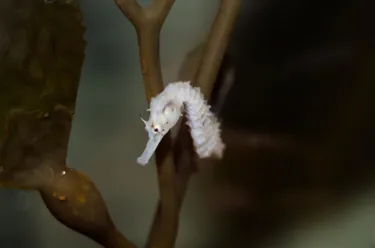Dance of the Seadragons
- Thursday 11th April 2013
- Seahorses

Seahorse Safari is SEA LIFE Sydney Aquarium's brand new expedition that will take you on a journey of discovery into the world of the secret seahorse and the seahorse family and discovery many fascinating facts!
For example, did you know that while, for most couples in the animal kingdom, it is the female who becomes pregnant and cares for the young, but for seahorses - and their relatives Sea Dragons and Pipefish - it is the male does the hard work of carrying and delivering the babies.
Now, this may not be a new fact to you, "everyone knows the male seahorse carries the babies" you might say, but the process leading up to a male becoming pregnant is just as amazing and not always as well known.
For Seahorses and Dragons, just like human couples, courtship is very important and without the right conditions for courtship, mating may never occur.
Courtship and mating varies slightly from species to species, but generally it is around spring that seahorses will breed. Whilst not monogamous throughout their whole life, it is believed that some species of seahorses, once coupled, will stay together throughout that breeding season, potentially producing several broods together within a season. They are usually spotted close together, keeping an eye on each other, and have been observed greeting each other every morning.
This greeting, like the beginning of the mating courtship, involves a very graceful dance between the partners. The male will circle around the female, with them both spiraling upwards in the water. The male or female may change to a different colour during their dance, and the male will often inflate his brood pouch - presumably to show off to the female how big his pouch is, and what a great Dad he'd make.
Our Potbelly Seahorses here at SEA LIFE Sydney Aquarium, do this to the extreme, puffing up their pouches until they almost as big as a golf ball, a very impressive display - even if you're not a female seahorse.
In some species, such as the Weedy Sea Dragon, the vertical space in the water column is very important to successful mating, as the actual process of the female passing her eggs to the male may not occur until they have "danced" rising upwards for as much as 5 metres.
This is something that has been difficult to achieve in many captive settings, but despite these challenges still there has been success breeding seahorses at SEA LIFE Sydney Aquarium.
During their dance, the female will let the male know she is keen to mate by lifting her snout upwards, and the male will respond in the same way. As they slowly rise together the female will press against the males belly placing her ovipositor into the males pouch opening and transfer her eggs across.
As they separate and descend back down to the bottom the male will twitch and twist from side to side, to attach the eggs to the membranes in his pouch where they will then be fertilised. In Sea Dragons and Pipefish, the process is similar, but rather than the female placing her eggs in the males pouch (as the males do not have brood pouches), they are rubbed and pressed onto a specially prepared area on the tail, where they are then fertilised.
So, that is how the miracle of male pregnancy occurs! From there the male will incubate the eggs until the young are ready to hatch - usually about 1-2 months depending on the species. As the baby seahorses hatch from their eggs, the male "gives birth" to them, popping out little miniature versions of himself from his pouch.
The young generally fend for themselves after this and Dad is ready for his next pregnancy. And with the female ready to mate again a few days after the male gives birth, the dance begins again.
This is just one amazing fact about these truly amazing creatures. Learn more at SEA LIFE Sydney Aquarium's Seahorse Safari these school holidays!